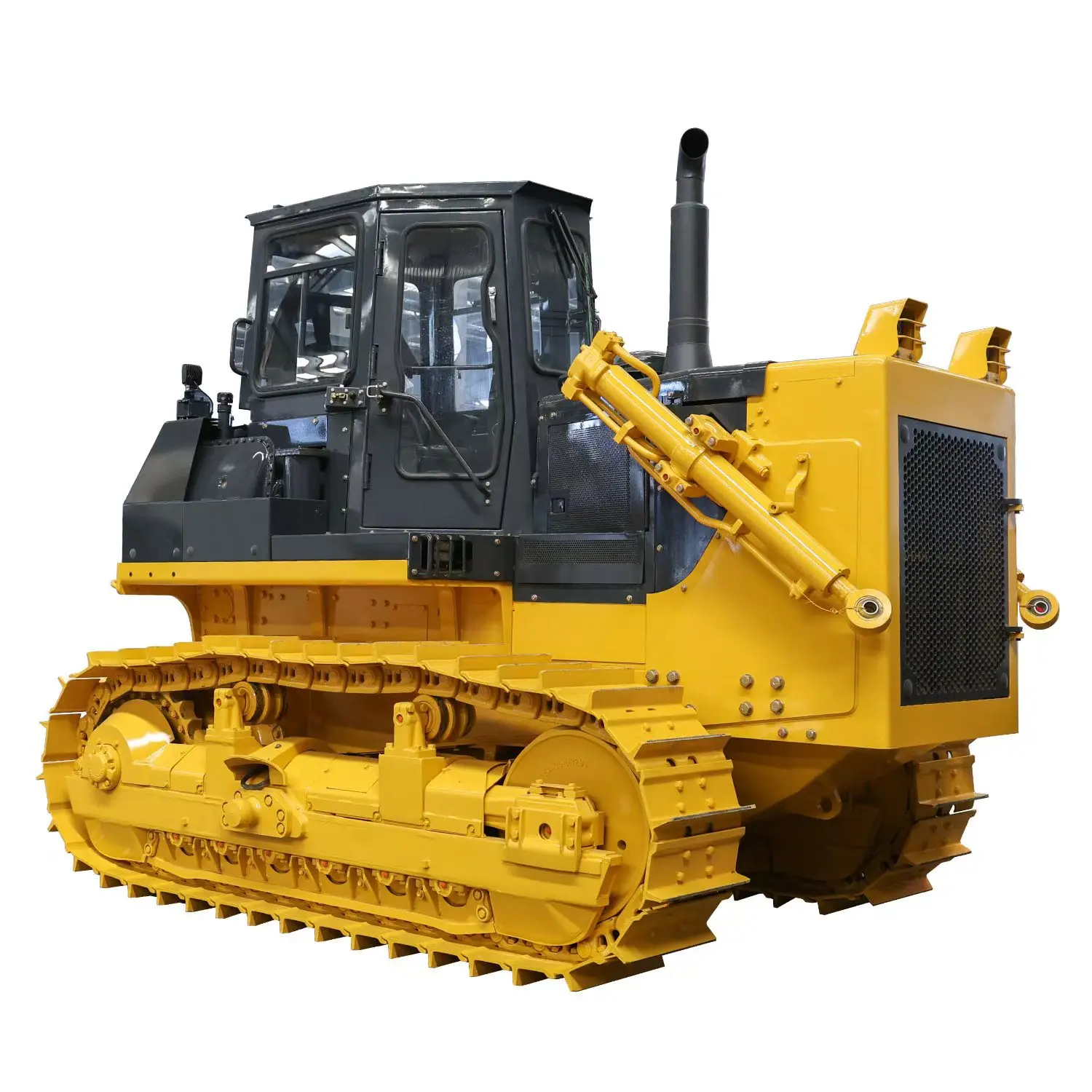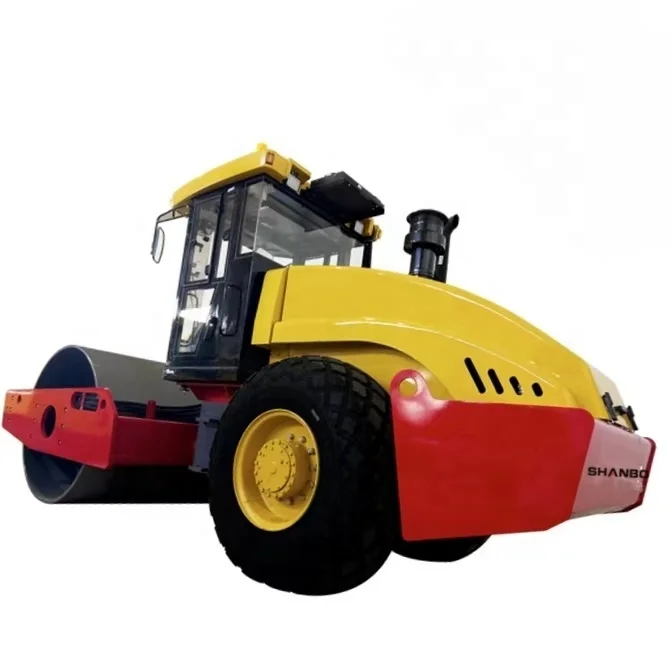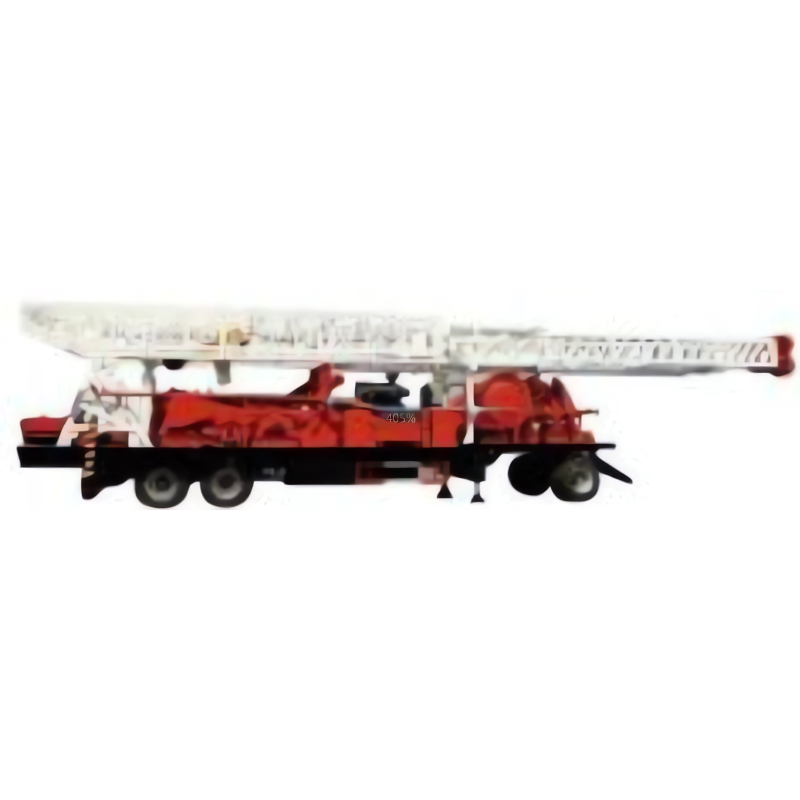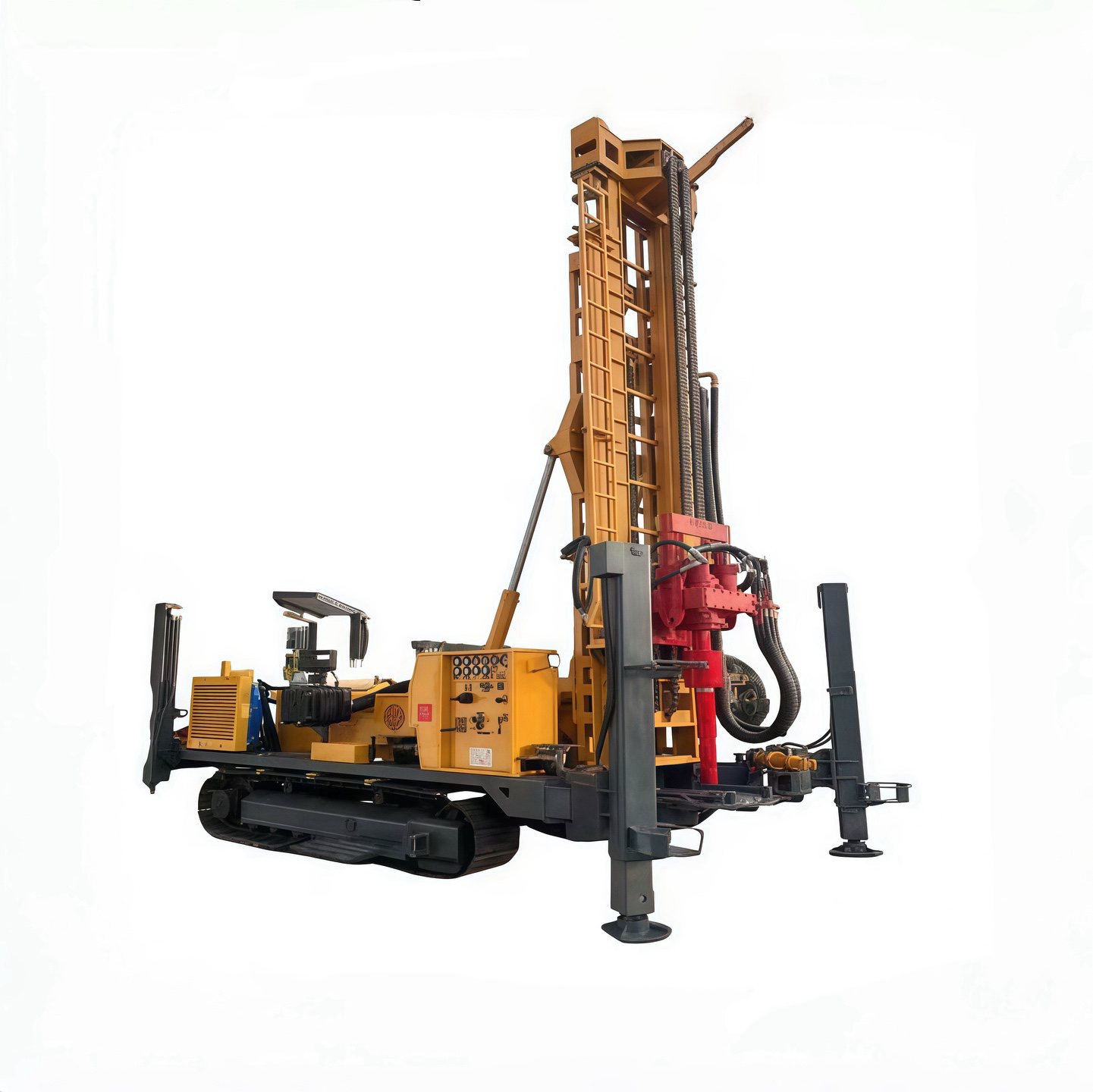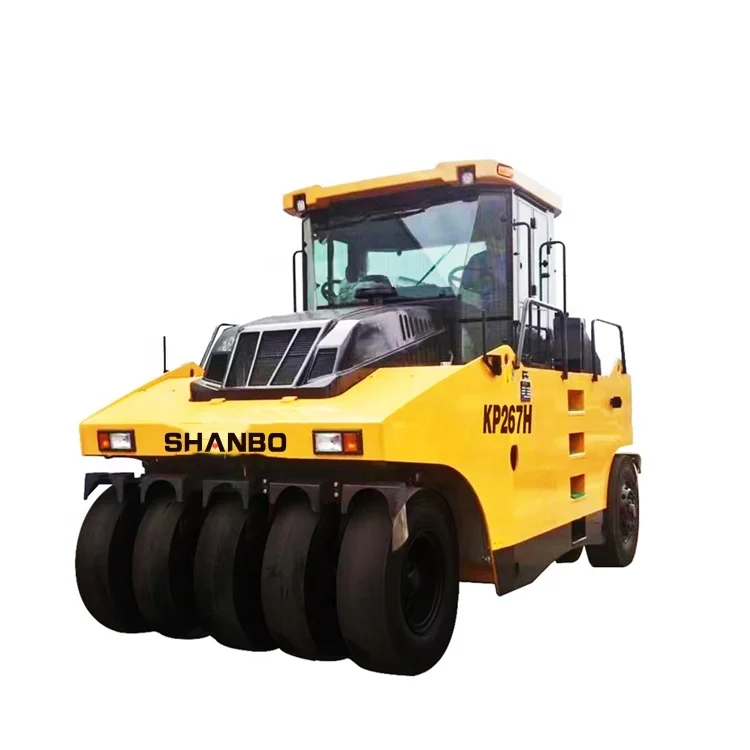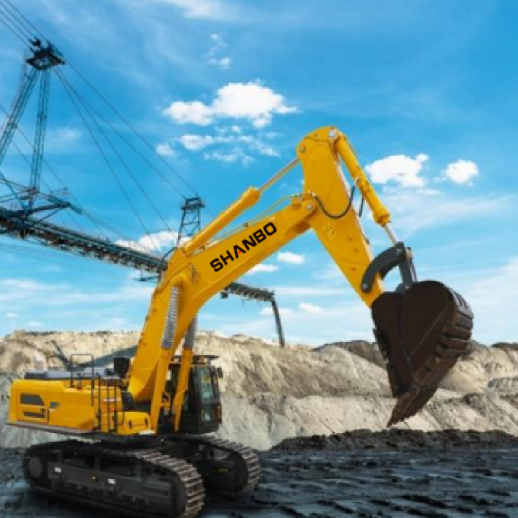Máy xúc lật và Máy ủi: Những Sự Khác Biệt Chính Bạn Cần Biết
Sự Khác Nhau Về Chức Năng Cốt Lõi Giữa Máy Xúc Trước Và Máy Ủi Đất
Xử Lý Vật Liệu So Với Khả Năng San Lấp
Máy xúc lật phía trước thực sự nổi bật khi so sánh khả năng xử lý vật liệu của chúng với các công việc san lấp mặt bằng. Những cỗ máy hạng nặng này hoạt động hiệu quả trong việc nâng và di chuyển đủ loại vật liệu trên khắp các công trường xây dựng. Chúng xử lý vật liệu rời đặc biệt tốt, chẳng hạn như sỏi, cát hoặc đất mà không gặp nhiều khó khăn. Điểm mấu chốt trong thiết kế của chúng là cho phép bốc dỡ nhanh chóng với những chiếc gầu xúc lớn được gắn kèm. Đó là lý do tại sao chúng rất hữu ích tại các công trường, nơi việc vận chuyển vật liệu đến đúng nơi cần đến rất quan trọng. Các nhà thầu tin tưởng sử dụng máy xúc lật phía trước hàng ngày vì chúng hoàn thành công việc nhanh hơn hầu hết các lựa chọn thay thế khác.
Máy ủi đất được thiết kế ngay từ đầu cho công việc san lấp mặt bằng quy mô lớn. Những cỗ máy này có bánh xích chắc chắn và lưỡi ủi phía trước rộng, cho phép chúng đẩy một lượng lớn đất và đá vụn xung quanh công trường. Đó là lý do tại sao các nhà thầu sử dụng máy ủi đất khi họ cần hoàn thành các dự án đào đất lớn hoặc san phẳng các khu vực đất không bằng phẳng. Điều làm cho những cỗ máy này trở nên giá trị trên các công trường xây dựng là khả năng xử lý địa hình gồ ghề một cách dễ dàng. Ngay cả trong những điều kiện khắc nghiệt nhất mà các loại máy móc khác khó có thể vượt qua, máy ủi đất vẫn tiếp tục hoạt động, dọn đường qua những địa hình đá và san phẳng những ngọn đồi thành bề mặt có thể sử dụng để xây dựng nền móng.
Cơ chế nâng vs Sức mạnh đẩy
Máy xúc lật sử dụng hệ thống thủy lực phức tạp để vận hành cơ cấu nâng, cho phép xếp chồng và nạp vật liệu chính xác. Khả năng điều chỉnh độ cao nâng giúp máy móc này đủ linh hoạt cho mọi loại công việc tại công trường xây dựng, từ di chuyển sỏi đến chất đống các khối bê tông lớn. Hệ thống thủy lực này cho phép người vận hành kiểm soát cách thức nâng và đặt vật liệu, một yếu tố rất quan trọng khi thực hiện các dự án đòi hỏi vật liệu phải được đưa đến đúng vị trí cần thiết mà không có bất kỳ sai sót nào.
Trái ngược hoàn toàn, máy ủi ưu tiên sức đẩy và sự ổn định, được thúc đẩy bởi hệ thống lưỡi ủi mạnh mẽ. Những hệ thống này được thiết kế để tạo ra lực tác động tối đa lên mặt đất, giúp chúng có khả năng di chuyển khối lượng lớn một cách hiệu quả trong khi vẫn giữ được sự ổn định trong nhiều điều kiện khác nhau.
Máy ủi đất sở hữu lưỡi ủi lớn, giúp chúng hoàn toàn bất khả chiến bại khi thực hiện các công việc đẩy vật nặng. Không có thiết bị nào khác trên công trường có thể sánh được với khả năng của chúng trong việc dọn dẹp đất đai hoặc di chuyển một lượng đất lớn. Cách chế tạo những cỗ máy này mang lại cho chúng lợi thế về sức mạnh đáng kinh ngạc so với các thiết bị khác. Tuy nhiên, máy xúc lật hoạt động theo một cách khác. Chúng phù hợp hơn với những công việc đòi hỏi sự tinh tế hơn là sức mạnh cơ bắp. Các đội xây dựng thường sử dụng máy xúc lật khi cần xử lý các vật liệu mỏng manh hoặc làm việc trong không gian chật hẹp mà không gây hư hỏng. Cả hai loại máy đều đóng vai trò quan trọng nhưng lại vượt trội trong những tình huống hoàn toàn khác nhau tùy thuộc vào yêu cầu thực tế của công việc.
Thiết Kế Kết Cấu Và Hệ Thống Di Chuyển
Hệ Thống Dây Chuyền (Ổn Định Của Máy Ủi)
Máy ủi được trang bị hệ thống gầu rộng rãi, giúp tăng cường sự ổn định và phân phối trọng lượng, khiến chúng trở thành lựa chọn lý tưởng cho địa hình khó khăn. Những gầu mạnh mẽ này cho phép máy ủi hoạt động hiệu quả trên bề mặt đất không bằng phẳng và lỏng lẻo, điều này rất cần thiết trong các nhiệm vụ đào đất đòi hỏi cao.
Hệ thống ray được thiết kế để ngăn thiết bị trượt hoặc lật hoàn toàn, điều này khiến chúng trở nên thực sự quan trọng khi di chuyển vật nặng cần cả độ chính xác lẫn sức mạnh cơ bắp. Theo một số số liệu trong ngành mà chúng tôi đã thấy, máy ủi thực sự hoạt động khá tốt ngay cả trên những sườn dốc hơn 30% nhờ vào kết cấu của chúng. Cách những cỗ máy này xử lý địa hình dốc cho thấy tầm quan trọng của kỹ thuật hệ thống ray tốt đối với các công trường xây dựng và hoạt động khai thác mỏ, nơi mà sự ổn định là yếu tố quan trọng nhất.
Cấu Hình Lốp (Khả Năng Di Chuyển Của Máy Kéo Trước)
Máy kéo trước thường được trang bị cấu hình bánh xe, cung cấp khả năng di chuyển vượt trội so với hệ thống gầu được sử dụng bởi máy ủi. Ưu điểm về tính cơ động này làm cho máy kéo trước rất phù hợp cho các công trường chật hẹp, nơi không gian thường là hạn chế.
Thiết kế có bánh xe cho phép bán kính quay hẹp hơn và các chuyển động linh hoạt, đặc biệt hữu ích trong môi trường đô thị hoặc công trường xây dựng nơi độ chính xác là yếu tố then chốt. Thiết kế của chúng tuân thủ các tiêu chuẩn ngành để đảm bảo vận chuyển và tải vật liệu hiệu quả, cho phép người vận hành thực hiện các nhiệm vụ nhanh chóng và an toàn trong nhiều điều kiện khác nhau.
Cấu trúc khung cho các nhiệm vụ nặng
Cả máy xúc và máy ủi đều có cấu trúc khung vững chắc được thiết kế để chịu được áp lực hoạt động cực đại tại các công trường xây dựng. Máy ủi thường có khung cấu trúc được gia cố, giúp chúng chịu được những áp lực lớn khi đẩy đất cứng hoặc các vật liệu cồng kềnh trong thời gian dài.
Máy xúc trước, trong khi đảm bảo tính toàn vẹn cấu trúc, tập trung nhiều hơn vào khả năng nâng, điều này có thể ảnh hưởng đến độ mạnh mẽ tổng thể của chúng khi so sánh trực tiếp với máy ủi. Tuy nhiên, máy xúc trước rất năng lực trong phạm vi hoạt động của mình và là vô giá cho các nhiệm vụ xử lý vật liệu, nhờ vào hệ thống nâng hiệu quả và thiết kế vững chắc.
Công Cụ Làm Việc: Lưỡi vs. Cơ Chế Thùng
Kiểu Lưỡi Máy Ủi (S-Blade, U-Blade)
Máy ủi có thể được trang bị các loại lưỡi khác nhau, chẳng hạn như S-Blade và U-Blade, mỗi loại được thiết kế cho các nhiệm vụ cụ thể để tăng cường khả năng di chuyển đất. Lưỡi S-Blade phù hợp cho việc san phẳng chính xác, trong khi U-Blade xuất sắc trong các nhiệm vụ cạo đất nhờ khả năng giữ nhiều vật liệu hơn.
Thống kê cho thấy việc chọn loại lưỡi cày phù hợp có thể tăng hiệu suất lên đến 30% trong các ứng dụng đào đất khác nhau. Mặc dù máy ủi thường là những chiếc máy mạnh mẽ, việc hiểu và sử dụng chức năng của mỗi loại lưỡi cày là rất quan trọng đối với người vận hành muốn tối ưu hóa năng suất trong các dự án của họ.
Phụ kiện xẻng phía trước
Hầu hết các máy xúc lật đều được trang bị đủ loại phụ kiện gầu xúc khác nhau, giúp tăng cường đáng kể khả năng làm việc của chúng trong nhiều công việc khác nhau. Chúng ta đang nói đến tất cả mọi thứ, từ gầu xúc thông thường cho đến những gầu xúc cao cấp được thiết kế riêng cho công việc cảnh quan, đào rãnh, hoặc vận chuyển vật liệu rời. Điều làm nên giá trị của những chiếc máy này là khả năng thay thế phụ kiện nhanh chóng ngay cả khi người vận hành vẫn đang làm việc tại công trường. Điều này giúp giảm thời gian chờ đợi giữa các công việc, một yếu tố rất quan trọng khi các đội thi công đang chạy đua với thời hạn gấp rút trên các công trường xây dựng, nơi mà từng phút giây đều quý giá.
Các nghiên cứu hỗ trợ rằng việc lựa chọn kỹ lưỡng các phụ kiện máy xúc dựa trên yêu cầu cụ thể của dự án có thể cải thiện đáng kể kết quả, giúp vận chuyển và tải vật liệu hiệu quả hơn.
Tùy chỉnh Máy Xúc Thủy Lực
Hệ thống thủy lực ở máy xúc front loader cung cấp khả năng tùy chỉnh đáng kể, cho phép người vận hành điều chỉnh thiết bị cho các ứng dụng cụ thể và có được sự kiểm soát tốt hơn đối với các công việc xếp dỡ và nâng hạ. Các tùy chọn tùy chỉnh như dòng chảy thủy lực tăng cường góp phần vào thời gian nâng nhanh hơn và hiệu suất hoạt động tốt hơn.
Các đánh giá trong ngành cho thấy rằng những giải pháp thủy lực được tùy chỉnh này có tiềm năng nâng cao năng suất tổng thể tại công trường, mang lại cho người vận hành một lợi thế chiến lược trong việc quản lý các dự án phức tạp và thích ứng hiệu quả với các nhu cầu xử lý vật liệu khác nhau.
Thông số Công suất và Hiệu năng
So sánh Công suất Động cơ
Việc xem xét sự khác biệt về công suất động cơ giữa máy ủi và máy xúc lật thực sự phụ thuộc vào chức năng thực tế của từng loại máy tại công trường. Hầu hết các máy ủi đều được trang bị động cơ lớn với công suất từ 80 đến thậm chí hơn 500 mã lực. Công suất này hợp lý khi những máy này cần đẩy qua địa hình gồ ghề hoặc kéo vật nặng qua các công trường. Tuy nhiên, máy xúc lật lại hoạt động theo cách khác. Động cơ của chúng thường nằm trong khoảng từ 50 đến 400 mã lực tùy thuộc vào kích thước máy. Những máy này tập trung nhiều hơn vào việc xúc đất, sỏi hoặc mảnh vụn thay vì đẩy bằng sức mạnh thô bạo. Các mẫu máy cấp thấp xử lý các công việc nhỏ hơn trong khi các đơn vị lớn hơn giải quyết các nhiệm vụ di chuyển vật liệu nặng hơn mà không cần quá nhiều sức mạnh thô như máy ủi.
Sự khác biệt về công suất phản ánh vai trò cơ bản mà mỗi máy móc đảm nhận. Nghiên cứu chỉ ra rằng việc chọn thiết bị phù hợp với công suất thích hợp là yếu tố then chốt để đạt hiệu suất tối ưu tại các địa điểm công việc cụ thể. Bằng cách chọn đúng máy móc, quản lý dự án có thể đảm bảo hiệu quả và hiệu suất trong việc hoàn thành các nhiệm vụ dự án.
Hiệu suất tiêu thụ nhiên liệu trong hoạt động đào đất
Hiệu suất tiêu thụ nhiên liệu là một yếu tố quan trọng trong các hoạt động earthmoving, ảnh hưởng đến cả chi phí và dấu chân môi trường. Các máy ủi hiện đại được thiết kế để tối ưu hóa việc tiêu thụ nhiên liệu, đặc biệt cho các hoạt động kéo dài đòi hỏi phải đẩy và làm phẳng liên tục. Sự tiến bộ này mang lại lợi thế đáng kể trong các dự án thời gian dài, nơi chi phí nhiên liệu tích lũy.
Máy xúc lật phía trước hướng đến hiệu quả nhiên liệu tốt trong thiết kế của chúng, mặc dù chúng thường gặp sự cố khi người vận hành chuyển đổi giữa các phụ kiện khác nhau trong ngày. Khối lượng công việc đa dạng mà những chiếc máy này xử lý từ sáng đến tối tạo ra những sự thiếu hiệu quả bất ngờ mà không phải lúc nào cũng được tính đến trong bảng thông số kỹ thuật. Điều này có nghĩa là tại công trường, việc lập kế hoạch phù hợp cũng quan trọng như việc có thiết bị hiệu quả. Một số công ty xây dựng báo cáo tiết kiệm được khoảng 15% chi phí nhiên liệu hàng tháng sau khi chuyển sang các mẫu máy hiệu quả hơn, trong khi những công ty khác gặp khó khăn vì họ không chọn đúng máy phù hợp với công việc. Việc kiểm tra bảo dưỡng thường xuyên cũng trở nên cần thiết, vì ngay cả những vấn đề nhỏ như bộ lọc khí bẩn cũng có thể phủ nhận tất cả những khoản tiết kiệm tiềm năng đó. Vào cuối ngày, việc cân bằng các mối quan tâm về ngân sách với các sáng kiến xanh đòi hỏi phải nhìn xa hơn mức giá niêm yết của máy móc mới.
Trọng lượng hoạt động và khả năng tải
Khi nói đến công việc san lấp đất, trọng lượng của máy và khả năng chịu tải của nó thực sự quan trọng để hoàn thành công việc một cách tốt nhất. Máy ủi thường khá nặng, điều này thực sự giúp chúng giữ thăng bằng trên mặt đất khi cần đẩy qua những vật liệu cứng. Trọng lượng tăng thêm đó tạo nên sự khác biệt lớn trên địa hình gồ ghề, nơi những chiếc máy nhẹ hơn chỉ làm bánh xe quay tròn. Trọng lượng tăng thêm giúp những cỗ máy này bám đất tốt hơn và tránh bị lật, một điều cực kỳ quan trọng khi dọn đất hoặc san phẳng các công trường xây dựng. Người vận hành hiểu rõ điều này sau nhiều năm làm việc trên những cánh đồng lầy lội và sườn đồi đá, nơi việc phân bổ trọng lượng hợp lý giúp tiết kiệm cả thời gian và hao mòn thiết bị.
Máy xúc lật có nhiều tải trọng khác nhau, được thiết kế chủ yếu để nâng và di chuyển vật liệu thay vì đẩy chúng đi khắp nơi. Điều này khiến chúng khá linh hoạt cho mọi loại công việc xây dựng tại công trường. Xem xét dữ liệu thực tế tại hiện trường cho thấy việc biết chính xác khả năng chịu tải của máy về trọng lượng và công suất thực sự quan trọng để hoàn thành công việc một cách hiệu quả. Khi người vận hành so sánh các thông số kỹ thuật này với nhu cầu cụ thể của một công việc, họ không chỉ đạt được kết quả tốt hơn mà còn tránh được các tai nạn tiềm ẩn do thiết bị quá tải. Hầu hết các nhà thầu sẽ nói với bạn rằng sự chú ý đến chi tiết này giúp tiết kiệm thời gian và tiền bạc về lâu dài.
Khả năng thích ứng với địa hình và ứng dụng tại công trường
Hiệu quả của máy ủi trên địa hình gồ ghề
Máy ủi được chế tạo tỉ mỉ để hoạt động xuất sắc trên địa hình gồ ghề và không bằng phẳng, khiến chúng trở thành lựa chọn lý tưởng để vượt qua chướng ngại vật và xử lý các điều kiện mặt đất khó khăn. Hệ thống bánh xích của chúng là một tính năng nổi bật, được thiết kế để duy trì lực bám đường và tăng cường sự ổn định ngay cả trong những môi trường thách thức nhất.
Điều này cho phép máy ủi vượt trội hơn đáng kể so với máy xúc trước, đặc biệt trong các nhiệm vụ như khai thác mỏ, san lấp và chuẩn bị mặt bằng. Các báo cáo từ hiện trường liên tục nhấn mạnh hiệu suất tuyệt vời của máy ủi cho các công việc cụ thể này, xác nhận sự ưu việt của chúng khi xử lý các công trường đa dạng và nặng nhọc.
Lợi thế của Máy Xúc Trước Mini trong Không Gian Hẹp
Trái lại, máy xúc trước, đặc biệt là các mô hình nhỏ gọn, là những nhà vô địch trong không gian hẹp, nơi mà các loại máy móc lớn hơn có thể gặp vấn đề về tính thực tiễn do hạn chế về kích thước. Thiết kế của chúng thúc đẩy khả năng điều khiển vượt trội, cho phép người vận hành thực hiện khéo léo các nhiệm vụ xúc và xử lý vật liệu mà không gây tổn hại đến khu vực xung quanh.
Điều này khiến chúng đặc biệt có lợi trong các dự án xây dựng đô thị. Nhiều nghiên cứu điển hình đã xác nhận rằng sự linh hoạt và hiệu quả hoạt động của máy xúc trước nhỏ gọn mang lại lợi ích rõ rệt cho các dự án như vậy bằng cách cung cấp hiệu suất liền mạch và khả năng thích ứng trong các môi trường bị hạn chế.
Các tình huống Khai thác mỏ và Nghiền đá
Khi nói đến các tình huống khai thác mỏ và nghiền đá, máy ủi thường là thiết bị được lựa chọn vì thiết kế mạnh mẽ và khả năng xử lý các nhiệm vụ nặng nề. Chúng rất giỏi trong việc đẩy hoặc san phẳng một lượng lớn vật liệu, từ đó giúp các hoạt động trong những môi trường đòi hỏi và áp lực cao trở nên suôn sẻ hơn.
Các cuộc khảo sát trong ngành liên tục cho thấy việc sử dụng máy ủi đất giúp hoàn thành dự án nhanh hơn trong bối cảnh khai thác mỏ và khai thác đá, nhấn mạnh hiệu quả của chúng như những công cụ không thể thiếu đối với các ngành này. Thành công này là nhờ vào năng lực xây dựng và vận hành của chúng, đáp ứng được các yêu cầu khắt khe của môi trường như vậy.
Phân tích Chi phí và Cân nhắc Vận hành
Chi phí Mua Ban Đầu (Máy Ủi so với Máy Nạp Trước)
Khi nói đến việc mua máy ủi đất so với máy xúc lật, có một khoảng cách khá lớn giữa số tiền mọi người phải trả ban đầu. Điều này liên quan đến cách thức hoạt động và mục đích sử dụng của chúng. Máy ủi đất về cơ bản được chế tạo giống như xe tăng để làm việc trên nền đất thô, điều này giải thích tại sao thoạt nhìn chúng có giá cao hơn nhiều. Hãy xem xét các con số và mọi thứ sẽ rõ ràng hơn. Máy ủi đất nhỏ có thể có giá khởi điểm khoảng ba mươi ngàn đô la, nhưng nếu mua những chiếc lớn hơn, được thiết kế để san lấp mặt bằng quy mô lớn, giá có thể lên tới hơn một trăm ngàn đô la. Sự chênh lệch này rất quan trọng khi lập ngân sách cho các dự án xây dựng hoặc hoạt động san lấp mặt bằng.
Trái lại, máy xúc bánh lốp thường tiết kiệm hơn, với giá dao động từ 25.000 USD đến 70.000 USD. Hiểu rõ những sự khác biệt về tài chính này là rất quan trọng cho việc lập kế hoạch ngân sách hiệu quả trong các dự án xây dựng. Việc xem xét khoản đầu tư ban đầu giúp đánh giá khả năng tài chính tổng thể và lên kế hoạch cho nhu cầu thiết bị trong tương lai.
Chi phí bảo trì dài hạn
Việc bảo trì thiết bị nặng liên quan đến các chi phí dài hạn khác nhau giữa máy ủi và máy xúc bánh lốp. Máy ủi thường phát sinh chi phí bảo trì cao hơn do hệ thống cơ khí phức tạp, được thiết kế cho các nhiệm vụ đòi hỏi như khai thác mỏ và san lấp mặt bằng.
Máy xúc lật cửa trước thường có chi phí bảo trì thấp hơn, đặc biệt là khi được triển khai ở những nơi thực sự cần thiết, chẳng hạn như các công trường xây dựng đô thị, nơi không gian hạn hẹp. Bản thân máy được chế tạo đơn giản hơn nhiều loại máy khác, kết hợp với khả năng xử lý nhiều nhiệm vụ khác nhau, giúp người vận hành thường tiết kiệm chi phí sửa chữa sau này. Khi lập ngân sách cho các dự án mới, đừng quên tính đến những khoản tiết kiệm này. Kinh nghiệm thực tế cho thấy việc lập kế hoạch bảo trì hợp lý có thể cắt giảm đáng kể tổng chi phí trong suốt vòng đời của bất kỳ đội máy móc nào.
Tỷ suất hoàn vốn (ROI) cho các dự án nhỏ và lớn
Việc xem xét lợi tức đầu tư cho thiết bị xây dựng thực sự phụ thuộc vào loại công việc chúng ta đang nói đến và quy mô của nó. Đối với những công trình san lấp mặt bằng quy mô lớn, máy ủi thường mang lại lợi nhuận cao hơn vì chúng có thể di chuyển hàng tấn đất và mảnh vụn rất nhanh. Điều này giúp giảm chi phí nhân công vì cần ít công nhân hơn cho cùng một khối lượng công việc, và giúp toàn bộ dự án tiến triển nhanh hơn so với các máy móc nhỏ hơn. Các nhà thầu kiên trì sử dụng máy ủi tại các công trường lớn thường thu hồi vốn nhanh hơn so với các lựa chọn khác.
Ngược lại, máy xúc có thể mang lại tỷ suất lợi nhuận cao hơn cho các dự án nhỏ. Sự đa dụng và tốc độ trong việc xử lý vật liệu khiến chúng trở nên thuận lợi trong các công việc mà việc tải nhanh và khả năng cơ động quan trọng hơn sức đẩy thô. Đánh giá quy mô dự án cùng với khả năng của thiết bị đảm bảo các quyết định mua sắm tiết kiệm chi phí và kết quả vận hành tối ưu.
Chọn Thiết Bị Phù Hợp Cho Dự Án Của Bạn
Những Yếu Tố Chính: Quy Mô Dự Án Và Loại Vật Liệu
Khi chọn giữa máy xúc và máy ủi, cần phải xem xét quy mô dự án và loại vật liệu được xử lý. Đối với các dự án lớn, khả năng mạnh mẽ của máy ủi trong việc quản lý đất nén làm cho nó trở thành lựa chọn ưu tiên nhờ sức mạnh và hiệu quả tuyệt đối.
Mặt khác, máy xúc trước tỏa sáng khi làm việc với các vật liệu rời, cung cấp tốc độ và khả năng cơ động vượt trội trong việc xử lý các loại vật liệu này. Để tối ưu hóa hiệu suất và hiệu quả của thiết bị, cần phân tích kỹ lưỡng các yêu cầu cụ thể của dự án, xem xét cả quy mô dự án và loại vật liệu.
Khi nào nên chọn Máy ủi mini hoặc Máy xúc nhỏ gọn
Máy ủi mini và máy xúc nhỏ gọn hoạt động tốt trong các dự án quy mô nhỏ, nhờ thiết kế cân bằng giữa sức mạnh và khả năng cơ động. Máy ủi mini phù hợp cho các công việc đòi hỏi tính linh hoạt và dễ di chuyển, chẳng hạn như xây dựng dân dụng và công việc cảnh quan nơi không gian có thể bị hạn chế.
Tương tự, máy xúc phía trước nhỏ gọn hoạt động hiệu quả trong môi trường đô thị, mang lại lợi thế về hiệu suất ở những khu vực có giới hạn tiếp cận. Những máy móc nhỏ hơn này cung cấp nhiều lợi thế vận hành đáng kể, chứng minh giá trị của chúng trong các lĩnh vực chuyên biệt như phát triển đô thị và công việc cảnh quan chi tiết nơi sự chính xác là yếu tố hàng đầu.
Tóm tắt Ưu điểm và Hạn chế
Sức mạnh của Máy ủi trong công việc đẩy nặng
Khi nói đến việc đẩy những vật liệu cứng, không gì sánh bằng một chiếc máy ủi đất cũ kỹ cho những công việc nặng nhọc. Những cỗ máy này sở hữu động cơ mạnh mẽ và kết cấu chắc chắn, cho phép chúng cày xới xuyên qua những địa hình gồ ghề mà hầu hết các thiết bị khác sẽ bị mắc kẹt. Bất kỳ ai từng làm việc tại các công trường xây dựng đều biết những cỗ máy này vô cùng cần thiết trong quá trình san lấp mặt bằng hoặc dọn dẹp địa hình khó khăn. Các chuyên gia trong ngành thường coi máy ủi đất là tiêu chuẩn vàng để hoàn thành công việc một cách hoàn hảo, đặc biệt là khi thời gian là tiền bạc và mặt đất không bằng phẳng.
Khả năng này được hỗ trợ bởi lưỡi dao mạnh mẽ và bộ phá đá, khiến máy ủi trở thành tài sản thiết yếu tại các công trường xây dựng quy mô lớn, mỏ đá và hoạt động khai thác mỏ. Sức mạnh thô của máy ủi đảm bảo rằng chúng là máy móc hàng đầu cho nhu cầu đào đất lớn.
Tính linh hoạt của Máy xúc trước cho dự án đa nhiệm
Máy xúc trước được ca ngợi vì tính đa dụng vô song, khiến chúng trở thành công cụ không thể thiếu trong các dự án yêu cầu nhiều nhiệm vụ khác nhau. Từ việc di chuyển vật liệu đến đào đất tại công trường, khả năng chuyển đổi nhanh chóng giữa các phụ kiện mang lại sự linh hoạt không gì sánh được. Sự linh hoạt này cho phép chúng đáp ứng các yêu cầu khác nhau tại công trường, đảm bảo hiệu quả tối đa trong các hoạt động khác nhau.
Các nghiên cứu so sánh chỉ ra rằng các tổ chức tìm kiếm tính linh hoạt trong công việc sẽ thu được lợi ích đáng kể từ việc sử dụng máy xúc trước, vì chúng có thể tối ưu hóa quy trình làm việc và cải thiện tiến độ dự án. Việc giới thiệu các phụ kiện như càng nâng và cày tuyết còn tăng thêm tính đa dụng của chúng, cho phép thực hiện các công việc từ đào rãnh đến cày tuyết một cách hiệu quả.
Nhược điểm trong tình huống cần xem xét
Mặc dù có những điểm mạnh, cả máy ủi và máy xúc đều có những hạn chế cụ thể, tùy thuộc vào bối cảnh của dự án. Máy ủi, mặc dù mạnh mẽ trong việc đẩy và san phẳng, thiếu khả năng cơ động trong không gian hẹp, điều này có thể hạn chế hiệu quả của chúng trong các khu vực chật hẹp hoặc đô thị.
Máy xúc lật phía trước hoạt động tốt cho hầu hết các công việc nhưng lại không hiệu quả khi thực hiện các công việc nặng nhọc đòi hỏi lực đẩy lớn. Điều này khiến chúng không hoàn hảo cho một số công trường xây dựng cần phải di chuyển đất với khối lượng lớn. Một người vận hành giỏi hiểu rõ hạn chế này và cân nhắc khi lựa chọn thiết bị. Điều kiện công trường cũng rất quan trọng. Nếu mặt đất gồ ghề hoặc cần di chuyển khối lượng lớn một cách nhanh chóng, máy xúc lật phía trước sẽ không đáp ứng được. Các nhà thầu thông minh sẽ xem xét yêu cầu thực tế của công việc trước khi chọn máy. Đôi khi, điều đó có nghĩa là phải chọn một loại máy có tải trọng nặng hơn, ngay cả khi chi phí ban đầu cao hơn. Việc chọn đúng loại máy cho công việc luôn mang lại kết quả tốt hơn về lâu dài.
Kết Luận
Bài viết phân tích kỹ lưỡng sự khác biệt giữa máy xúc lật và máy ủi đất về chức năng, cách chế tạo và cách vận hành hàng ngày. Việc nắm rõ những điểm khác biệt này giúp mọi người lựa chọn thiết bị phù hợp với công trường để mọi việc diễn ra suôn sẻ. Khi phải đối mặt với những công việc đẩy khó khăn, đòi hỏi sức mạnh cơ bắp, máy ủi đất tỏ ra vượt trội. Trong khi đó, máy xúc lật xử lý tốt nhiều nhiệm vụ trong nhiều điều kiện thi công khác nhau. Quyết định thực sự phụ thuộc vào loại công việc cụ thể mà bạn sẽ phải đối mặt. Vận chuyển vật liệu, đào đất quy mô lớn hay những công việc đòi hỏi sự linh hoạt - cả hai loại máy đều mang đến những tính năng đặc biệt, phù hợp hơn với một số loại dự án nhất định.
Sản phẩm đề xuất
 Tin Tức Nổi Bật
Tin Tức Nổi Bật
-
“Thiết bị cứu nước” khoan giếng nước lưu thông ngược 200 m đã đến Uzbekistan
2025-03-28
-
Hướng dẫn Vận chuyển Máy ủi: Các Phương pháp Tốt nhất, Mẹo An toàn và Các Yếu tố Chi phí
2025-12-15
-
Hướng Dẫn Đầy Đủ Về Vận Chuyển Thiết Bị Xây Dựng: Các Phương Pháp, Chi Phí và Mẹo
2025-12-12
-
Cách Máy Ủi Làm Việc: Các Nhiệm Vụ Chính, Kỹ Thuật và Ứng Dụng
2025-12-11
-
Khám Phá Khả Năng Của Máy Xúc Lớn Nhất Thế Giới
2025-12-10
-
Thiết Bị Ủi Quan Trọng: Các Bộ Phận, Phụ Kiện Và Công Dụng
2025-12-09
